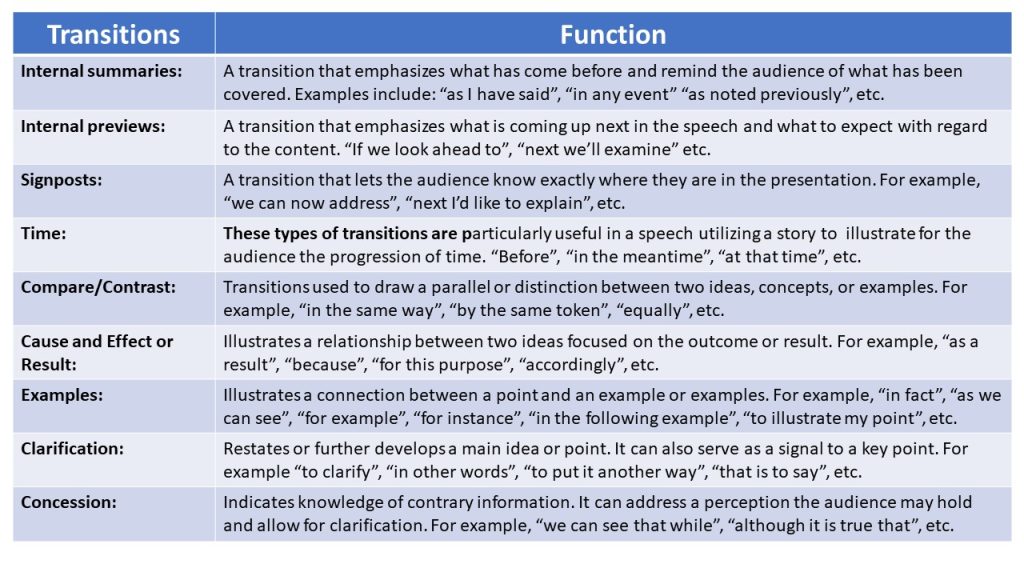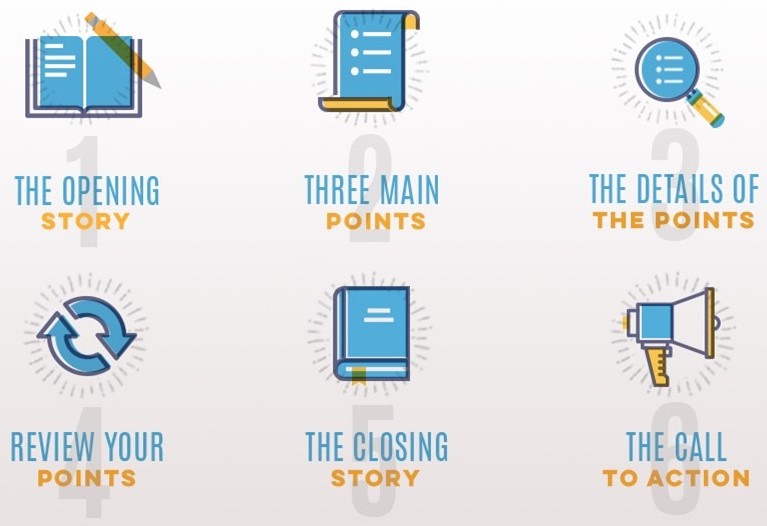79 Structuring Your Content (7.1.2)
Jordan Smith and Verna Johnson
Three-Part Structure for Presentations
In Learning Outcome 4 (LO4), you learned about the three-part structure used in many forms of business communication, such as emails, memos, and reports. This same structure is also a best practice for organizing presentations. It helps your audience follow your message and retain key information. Below is an overview of the three key parts of a well-structured presentation:
1. Introduction
Start strong. Your introduction sets the tone for the rest of your presentation.
-
Introduce yourself and state your topic clearly.
-
Hook your audience’s attention with something interesting, such as a surprising fact, a question, or a brief story.
-
Preview your general idea statement and main points so the audience knows what to expect.
-
Let the audience know how you’ll handle questions—for example, whether you’ll take them throughout the presentation or at the end.
“The next 10 minutes might save your life.”
“In the end, we will not remember the words of our enemies but the silence of our friends.”
Did these quotes heighten your interest in what the speaker is about to say?. During the first two to three minutes of a presentation, gaining the attention of listeners is crucial. Using words and phrases (like the ones above) and effective visual aids will make an immediate impact on listeners and capture their attention. Presentations that are able to capture the audience’s attention immediately are also more likely to keep the audience’s attention throughout. Take a minute to view these effective presentations attention getters from experienced and established speakers at TedTalks.
Effective attention-getting strategies that you can incorporate into a presentation include:
- Tell a compelling story that illustrates an important and relevant point.
- Ask a question that will get your audience thinking about your message.
- Share an intriguing, unexpected, or shocking detail.
- Open with an amusing observation about yourself, the subject, or the circumstances surrounding the presentation.
In addition to stimulating the listener’s interest, the introduction must also establish the speaker’s credibility and preview the main points of the presentation.
2. Body
This is the main section of your presentation, where you deliver your message. This section contains your research, main points, and other relevant information. It will follow your organizational pattern.
-
Present your key points in a logical order, following the structure you outlined in the introduction.
-
Support each point with relevant details, examples, data, or visuals.
-
Keep transitions clear to help your audience stay engaged and follow along.
Most of your presentation will be spent filling in the details of the main points first announced in the Introduction of your presentation. Effective presenters do not overwhelm their audience with too much information. Instead, effective presenters streamline their presentations by including only one or two important details for each main point. To accomplish this task, a presenter must be very informed on the topic and very aware of the audience in order to determine what information will be most impactful to a particular audience. No matter the audience, too much information can confuse listeners and conceal the central message of the presentation. So keep presentations simple and logical. Applying one of several organizing systems to a presentation will assist in streamlining information.
Transitions
An important part of any presentation is knowing how to connect your main points in a relevant manner so that your presentation appears fluid. Using transitional words and phrases is one method to help the audience follow the speaker’s ideas, connect the main points to each other, and see the relationships you’ve created in the information you are presenting. Transitions are used by the speaker to guide the audience in the progression from one significant idea, concept or point to the next issue. They can also show the relationship between the main point and the support the speaker uses to illustrate, provide examples for, or reference outside sources. Transitions can serve different roles depending on your purpose as you help create the glue that will connect your points in a way the audience can easily follow.
Table 11.1: Examples of Presentation Transitions 
3. Conclusion
Wrap up your presentation with confidence and clarity.
-
Summarize your main idea and key points to reinforce your message.
-
Share final thoughts or a call to action (what you want the audience to do or think about following your presentation), depending on your purpose.
-
Thank the audience for their time and attention.
-
Invite questions if appropriate.
The concluding section of a presentation acts very much like a concluding paragraph for an essay: it summarizes the information presented. However, the concluding section also provides additional benefits for presentations. An effective conclusion will
- Provide a transition signalling the end of the presentation
- Summarize the main themes of the presentation
- Leave the audience with specific and noteworthy takeaways
- Motivate the audience to take action
The conclusion should be memorable. Ask yourself the question: What do you want my audience to remember most? The answer to that question is the subject of your conclusion, so don’t just say the same things you said during the presentation. Breathe fresh air into the information or come at the information from another angle. End on a strong and positive note. Think through and plan your last remarks to ensure the audience walks away with a positive impression of you and your company.
Presentation Outline
You’re now ready to prepare an outline for your presentation. To be successful in your presentation, you’ll need two outlines: a preparation outline, and a speaking outline.
Preparation outlines are comprehensive outlines that include all of the information in your presentation. Your presentation outline will consist of the content of what the audience will see and hear. Eventually, you will move away from this outline as you develop your materials and practice your presentation.
Your speaking outline will contain notes to guide you; notes that are usually not shared with your audience. It will summarize the full preparation outline down to more usable notes. You should create a set of abbreviated notes for the actual delivery.
Your organizational model will help determine how you will structure your preparation outline (see below). You can use your presentation outline as a starting point to developing your speaking outline. It’s a good idea to make speaking notes to align with your main points and visuals in each section. See Unit 12 for more information on constructing an outline. Figure 33.4 provides the basic parts of a presentation outline.

Attribution
This section was adapted from Chapter 32 “Presentations – An Overview” in Communication Skills and is used under a Creative Commons Attribution 4.0 International license.
References
References are at the end of this chapter.
Media Attributions
- Presentations transitions
- presentation-outline

